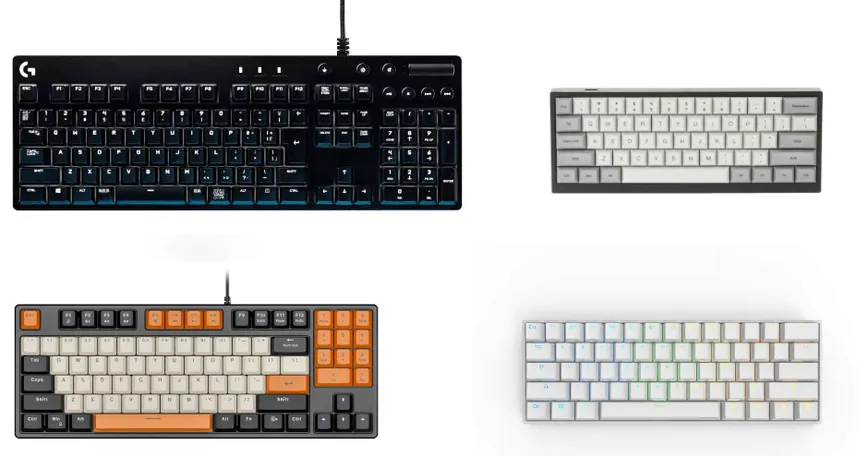
Summary of keyboard layout types and types
If you are particular about your keyboard, you will notice that there are many different keyboard layout types. In this article, we summarize the different types of keyboard layouts and the advantages and disadvantages of each type.
Modified at: 2023.5.10Posted at: 2022.6.29
Main keyboard layout types
Full-size keyboard (100+ keys)
This is a classic keyboard that has been around for a long time. In the image at the top of this article, the black keyboard in the upper left corner is a full-size keyboard.
- an area for typing letters called QWERTY
- special key area for arrow keys, DEL keys, etc.
- numeric keypad area
This is a general-purpose layout that can be applied to any task.
On the other hand, because of the inevitable increase in width, it has the disadvantage that when operating with a mouse, the mouse protrudes significantly to the right, creating an imbalance with the width of the shoulder.
The keyboards introduced hereafter were designed to resolve these disadvantages of full-size keyboards.
Tenkeyless keyboard (around 90 keys)
A full keyboard without numeric keypad. In the top image of this article, the keyboard on the left in the bottom row is a numeric keyless keyboard.
Numeric keyless keyboards have
- models with separate arrow keys, DEL keys, etc.
- a model with arrow keys and integrated layout on the main keys
There are two types of keyboards.
The independent model is often used in desktop keyboards, while the integrated-layout model is the standard layout for notebook PCs.
Which one is better depends on your preference. If you frequently use keys under the right shift, such as function, the independent model is easier to use, but the integrated layout is fine for the rest of us.
In particular, if you use a notebook PC and a desktop PC together, an integrated layout keyboard for the desktop PC will make you feel comfortable with key operations when using the notebook PC.
60% Keyboard (61 keys)
A 60% keyboard is a space-saving keyboard that omits more arrow keys and other keys from the numeric keyless keyboard. It is so called because the number of keys is reduced to about 60% of that of a full-size keyboard. In the top image of this article, it is the bottom keyboard on the right.
The 60% keyboard is even shorter in width than a tenkeyless keyboard, which not only makes for a cleaner desk, but also makes the keyboard itself smaller, so it is sometimes chosen for mobile use.
Many products lack tilde keys as well as arrow keys, but since these keys are complemented by function keys and shortcuts, the disadvantage is that they are more prone to strange habits than normal keyboards.
The 60% keyboard is also a keyboard layout that is rapidly gaining popularity in the FPS gaming and programming communities.
Since the arrow keys are generally not used in FPS games, the mouse can be placed to the left for the arrow keys, which has the advantage that the mouse and keyboard fit shoulder-width apart.
Also, in programming, many programmers "do not use the mouse and complete everything with the keyboard," such as the VIM method or the Emacs method for moving and copying, so a 60% keyboard with few wasted keys is ideal.
40% Keyboard (47 keys)
The 40% keyboard is a keyboard with fewer keys than the 60% keyboard. In the image at the top of this article, the keyboard on the top row on the right is a 40% keyboard.
It is called a 40% keyboard because the number of keys is reduced to about 40% compared to a full-size keyboard with more than 100 keys.
Since the number of keys is reduced to such a small number that it becomes insufficient for normal typing, symbols, etc., are basically used as shortcuts in combination with function keys.
The biggest advantage of the 40% keyboard is that the number of keys is reduced and space can be saved while maintaining the key size, but the disadvantage is that the key layout is so special that once you get used to it, you will have such strong habits that you cannot go back to a normal keyboard layout.
Compare the main keyboard layouts
Here is a comparison of the different layouts.
| Layout | Number of keys | Merits | Demerits |
|---|---|---|---|
| Full keys | 100+ keys | All inclusive Wide choice | Wide width |
| Ten-keyless | around 90 keys | slightly space-saving | difficult to input numbers |
| 60% keyboard | 61 keys | Space saving Easy to be mobile | Special input for symbols etc Somewhat strange habits |
| 40% keyboard | 47 keys | very space-saving Easy to be mobile | Special input for symbols etc. Sure to get into strange habits |
Ultimately, we can say that there are two choices: take the comfort of key input or take the comfort of space.
If you reduce the number of keys, you can save space and use narrower shoulders, which makes it easier to use in terms of posture, but key input becomes more specialized the more space saving you take it to the extreme.
On the other hand, a full-size keyboard with many usable keys means that it can be used in a variety of situations, making it more versatile, but it is also more difficult from a posture standpoint because the mouse is positioned farther to the right than shoulder width.
Which one you choose depends on your preference and what suits or does not suit you, so it is best to try a cheap keyboard.